Warmer Homes Scotland programme: annual review 2018-2019
A review of how the Warmer Homes Scotland Scheme - part of the Home Energy Efficiency Programmes for Scotland - has performed and made progress towards meeting its objectives.
Part 2: Objective 1 - Fuel Poverty
The first stated objective of Warmer Homes Scotland is to help to reduce levels of fuel poverty in Scotland by reducing the heating costs of those households who are living in or at risk of fuel poverty by providing measures to make their homes more energy efficient, comfortable and affordable to heat.
During the period of this review the Fuel Poverty (Targets, Definition and Strategy) (Scotland) Bill was making its way through Parliament. The Bill subsequently received Royal Assent on 18 July 2019 and is now an Act. This Act includes a new definition of fuel poverty in Scotland.[2].
As set out in section 3 of the Fuel Poverty (Targets, Definition and Strategy) (Scotland) Act 2019, a household is in fuel poverty if, in order to maintain a satisfactory heating regime, total fuel costs necessary for the home are more than 10% of the household’s adjusted net income (after housing costs), and if after deducting fuel costs, benefits received for a care need or disability and childcare costs, the household’s remaining adjusted net income is insufficient to maintain an acceptable standard of living. The remaining adjusted net income must be at least 90% of the UK Minimum Income Standard to be considered an acceptable standard of living, with an additional amount added for households in remote rural, remote small town and island areas.
Extreme fuel poverty follows the same definition except that a household would have to spend more than 20% of its adjusted net income (after housing costs) on total fuel costs and maintain a satisfactory heating regime
Warmer Homes Scotland uses certain proxies to identify those households that are likely to be living in or at risk of fuel poverty. The eligibility criteria for Warmer Homes Scotland is based on factors that indicate the likelihood of a household being in fuel poverty such as age, income and disability and is kept under review to ensure that the scheme helps those households that are most in need.
Eligibility
This review examined the two main aspects of the eligibility criteria in order to
- ensure that the criteria correctly identify fuel poor households; and
- determine if households that can be considered to be in fuel poverty do not meet the qualifying criteria for the scheme.
Figures 3 and 4 show the numbers of customers who were referred to Warmer Homes Scotland during 2018/19, broken down by the primary benefit they were in receipt of at the time of qualifying for the scheme, and by age.
Figure 3 shows that the top three qualifying criteria for the scheme, in terms of volume, remain the same as in the 2017/18 operating year.
The largest group of customers qualify for Warmer Homes Scotland based on their entitlement to Disability Living Allowance (DLA) or Personal Independence Payment (PIP) followed by those households supporting a child under 16 and in receipt of a qualifying benefit. The third largest group of customers are those over the age of 75 who are in receipt of a qualifying benefit.
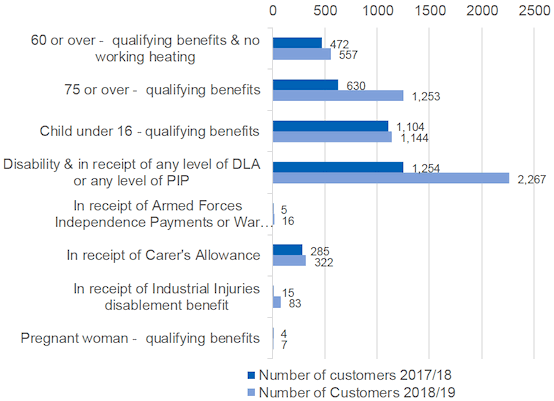
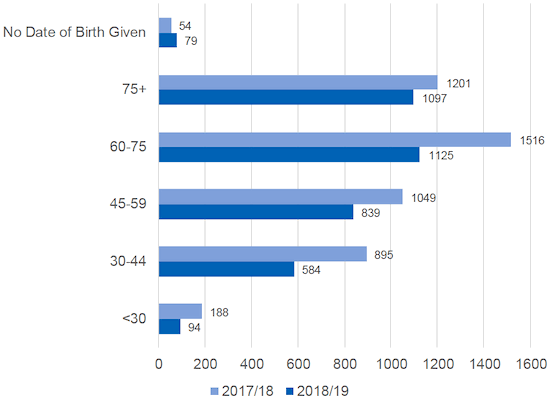
Analysis of Figure 3 demonstrates the breakdown of the primary benefits customers referred to the scheme are in receipt of and together with the age ranges demonstrated at Figure 4 indicates that those individuals in receipt of Carer’s Allowance, Industrial Injuries Disablement Benefit, War Disablement Pension, Armed Forces Independence Payment, and pregnant women have the lowest uptake of Warmer Homes Scotland. In addition, Figure 4 indicates that this is also true for those under the age of 30. As there are no figures available for the percentage of the population who are in receipt of these benefits in Scotland it is not possible to compare this group of Warmer Homes Scotland customers to the general population. The same is true for those households with all members under 30 who are living in fuel poverty.
The eligibility criteria is regularly reviewed to ensure that the scheme is providing help to those most in need but during the period of the 2018/19 review no changes were made.
The fuel poverty figures presented in the 2018 Scottish Housing Conditions survey (SHCS) are based on the best available estimates under the new definition of fuel poverty and outlines the key features of the fuel poor population in Scotland in 2018.
In 2018 an estimated 25.0% of all households were in fuel poverty, around 619,000 households. This is not statistically different to the 2017 fuel poverty rate of 23.7% (around 583,000 households).
Around 11.3% (279,000 households) were living in extreme fuel poverty in 2018 which is similar to the 11.9% (293,000 households) in the previous year.
The survey indicates that, of the households living in fuel poverty, around 15% are families with children, 36% are older one or two person households and 49% are other types of households with adult residents. In terms of housing tenure, 43% of fuel poor households are owner-occupiers, 41% are social housing residents and 16% private sector tenants.
Fuel poverty is affected by levels of household income, the price of fuel required for space and water heating, the energy efficiency of housing and the use of fuel in households. Fuel poverty is distinct from poverty in that, while low income is an important driver, it is not a prerequisite.
Fuel poor households are found in all income bands. Around 7% of all fuel poor households had weekly income above £400 before housing costs, which places nearly all of these households in the top half of the income distribution.
During 2018/19 Warmer Homes Scotland has delivered an average fuel bill saving of £313 per household, a decrease of 1.5% from the average fuel bill saving of £318 in 2017/18.
The average fuel bill savings are calculated by undertaking a whole house Green Deal Assessment (GDA) which are comprised of two elements – the standard Energy Performance Certificate (EPC), which determines the SAP rating of the home, and an Occupancy Assessment (OA), which takes lifestyle factors and household behaviours into account. This forms the basis of the recommendations made to the householder in terms of the measures that are recommended and installed under the scheme. Once all measures have been installed and successfully inspected, another EPC is then carried out to determine the new SAP rating of the property. Using the same software platform, the improvements in the SAP rating of the property are used to model the potential cost savings that a household might expect to gain as a result of the improvements made. However, it should be noted that these are modelled savings based on the underlying methodology of the software platform; no adjustment is made for householders taking some benefit in comfort and living in a warmer, healthier home. However, the modelled savings are still driven by industry-recognised processes and will always provide a guide as to the potential cost savings that householders can achieve.
The findings of the SHCS 2018 when compared to Figure 3 show that the use of proxies in determining eligibility for Warmer Homes Scotland is continuing to target support to those households who are most likely to be in fuel poverty.
The households with the largest uptake of Warmer Homes Scotland are those that have a member who has a disability as indicated by being in receipt of Disability Living Allowance, followed by households who are supporting young children or an older person aged 75 or over.
However, it should be noted that these numbers show the primary qualifying benefit for Warmer Homes Scotland and households may be in in receipt of more than one qualifying benefit.
This evidence supports the use of proxies in identifying those households who are living in or at risk of fuel poverty. However, as DLA and PIP are not means-tested benefits it cannot be concluded that the scheme is supporting only low-income households, although, it must be noted that customers in receipt of DLA may also be in receipt of other income-related benefits and this will not be reflected in these figures as Home Energy Scotland only records the primary qualifying benefit of customers referred to the scheme.
| Year | Owner-occupied | % of Total | Rented (private) | % of Total | Total |
|---|---|---|---|---|---|
| 2015-16 | 1159 | 83.5 | 213 | 15.5 | 1372 |
| 2016-17 | 4329 | 81 | 1025 | 19 | 5354 |
| 2017-18 | 4055 | 82.7 | 848 | 17.3 | 4903 |
| 2018-19 | 3675 | 96 | 143 | 4 | 3818 |
| Total | 13,218 | 86 | 2229 | 14 | 15,447 |
Table 1 shows that in 2018/19 the majority (86%) of Warmer Homes Scotland customers with completed installations were owner occupiers. However, there was significant decrease of 83% in the number of completed installations in the Private Rented Sector (PRS) from 2017/18 (13.3% in overall percentage terms). This is most likely due to changes made to the eligibility criteria in April 2017. This resulted in tenants of landlords in the private rented sector, with some exceptions for life tenancies and agricultural tenancies no longer being eligible for heating measures available under the scheme. This is because these properties are covered by the Repairing Standard contained in the Housing (Scotland) Act 2006. This places a duty on to landlords to ensure that heating in their properties is in good working order and is in a reasonable state of repair.
During the period of time this report covers, evidence suggests that the eligibility criteria appear to have captured those households living in or at risk of fuel poverty as, at that time a household was defined as being fuel poor if, in order to maintain a satisfactory heating regime, it would be required to spend more than 10% of its income on all household fuel use. However, these households may not strictly adhere to the definition of fuel poverty in Scotland at that time which specifically referred to income as benefits such as Disability Living Allowance are not means tested.
There may also have been some low-income households living in fuel poverty who did not qualify for Warmer Homes Scotland because they were not in receipt of one of the qualifying benefits. However, all callers to Home Energy Scotland, which is funded by the Scottish Government, are offered the opportunity of a benefit check to ensure that they are accessing all the support and assistance that they are entitled to receive.
The use of the UK Minimum Income Standard in the measurement of fuel poverty as set out in the Fuel Poverty (Targets, Definition and Strategy) Scotland Act subsequently introduced in June 2019 will help to improve the alignment between fuel poverty and income poverty.
Under the new definition of fuel poverty, those households that may not be income poor, but struggle to pay their fuel bills and maintain an adequate standard of living, will be captured.
Table 2 shows that during 2018/19, 714 applications were cancelled post-referral because they did not meet the eligibility criteria for the scheme. This represents an overall decrease of 6.2% when compared to 761 applications cancelled in the previous year.
The majority of these cancellations (92%) were due either to the SAP rating of the property being too high to qualify (50.3%), or that there were no suitable measures identified during the survey process that would improve the energy efficiency of the property (41.3%). In percentage terms this represents an overall decrease of 1% since 2017/18 when 93% of cancelled applications were done so for similar reasons.
From Table 2 we can see that during 2018/19 there has been an overall decrease of 12.6% in the number of cancelled applications post referral where the SAP of the property qualifies but there were no suitable measures. This represents a decrease of 115 in the number of households when compared to 2017/18. This reduction may be attributed to the addition of new renewable measures introduced to the scheme during 2018/19.
The suitability of available measures is examined in more detail in Part 4 of this review.
| Reason | 2018/19 | 2017/18 | ||
|---|---|---|---|---|
| No. | % of Total | No. | % of Total | |
| Applicant Less than 1 Year at Property | 13 | 1.8 | 12 | 1.6 |
| Applicant Not of Eligible Age and No Eligible Children | 0 | 0 | 2 | 0.3 |
| Applicant Not on Benefits | 27 | 3.8 | 15 | 1.9 |
| Applicant Proofs Missing | 11 | 1.5 | 10 | 1.3 |
| Property Housing Association/(Council Tenant) | 9 | 1.3 | 7 | 0.9 |
| Commercial Property | 0 | 0 | 0 | 0 |
| Multi-occupancy property | 0 | 0 | 0 | 0 |
| SAP - Too high | 359 | 50.3 | 305 | 40.1 |
| SAP Qualifies but no suitable measures | 295 | 41.3 | 410 | 53.9 |
| Total | 714 | 100 | 761 | 100 |
Analysis of cancellations rates between the owner occupied and private rented sector (PRS) following the change in the eligibility criteria in the 2017/18 reporting year has demonstrated that cancellation rates in the PRS sector, where no suitable measures were available, reduced from 37% in 2017/18 to 33% in 2018/19 an overall reduction of 4%, when compared to an overall reduction of 2% the in the owner occupied sector.
However, the volume of referrals for Private Rented Sector households reduced overall by 52% in 2018/19 from the previous year, which suggests that a much higher number of households did not proceed to making an application in the first place, either because they were no longer interested because they were unable to access heating measures or because Home Energy Scotland had established during the initial contact they did not meet the qualifying criterial for the scheme.
It is recognised that households in remote and rural areas that are not connected to the gas grid can have higher fuel costs than those households connected to the gas grid and those households living in urban areas. Consequently, under the definition of fuel poverty in Scotland, in use at the time of preparing this report, households in remote or rural areas were more likely to be living in or at risk of fuel poverty.
Therefore, it would be expected that the uptake of Warmer Homes Scotland would be proportionately greater in these areas.
| Region | Warmer Homes Scotland Completed installations | Population (mid 2016) | Installs per 1,000 People |
|---|---|---|---|
| Islands | 216 | 71,950 | 3.0 |
| Highlands | 347 | 321,900 | 1.1 |
| North East | 626 | 1,003,570 | 0.6 |
| South West | 370 | 520,080 | 0.7 |
| South East | 815 | 1,364,860 | 0.6 |
| Strathclyde and Central | 1444 | 2,122,340 | 0.7 |
| Scotland Total | 3818 | 5,404,700 | 0.7 |
Analysis of installations completed under Warmer Homes Scotland in 2018/19, indicates that as in previous years of the scheme’s delivery the uptake per head of population was greater in rural areas than in urban areas. Warmer Homes Scotland is designed to ensure people living in rural areas have equal access to the same measures as households living in urban areas despite the higher costs of installing these measures in remote, and rural areas.
Table 3 indicates that installs per 1,000 population was more than three times the national average in the Islands region.
Figure 5 shows a map of Warmer Homes Scotland installations in 2018/19 and Figure 6 shows maps of postcodes with a gas supply.
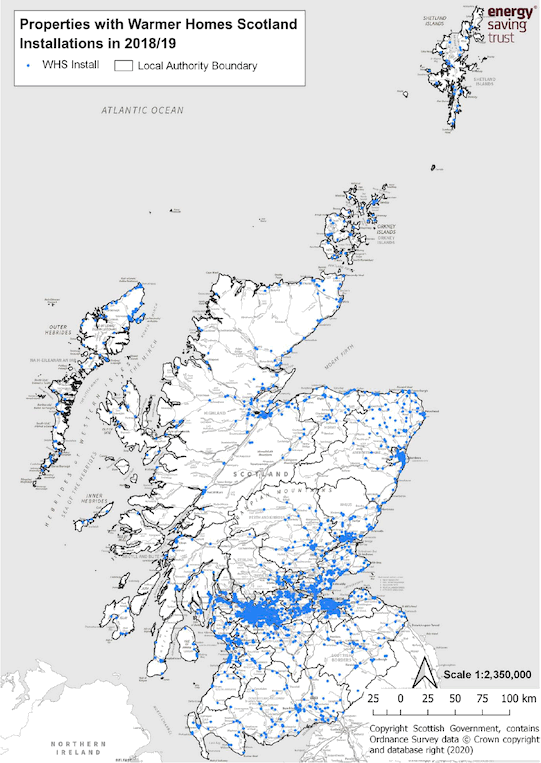
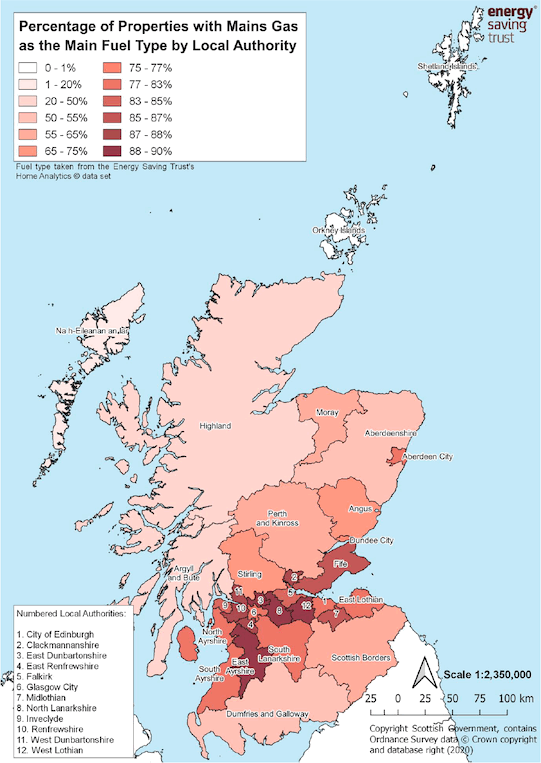
Awareness
Public awareness of Warmer Homes Scotland is important to ensure that the scheme reaches those households living in or at risk of fuel poverty and to ensure that these households are aware of the benefits of having energy efficiency measures installed under the scheme. Although a national marketing campaign for the scheme was not undertaken during 2018/19, Home Energy Scotland continue to actively promote referrals to Warmer Homes Scotland through their wide ranging partnership activity.
Attractiveness
The third element of accessibility of Warmer Homes Scotland is the attractiveness of the scheme to those households who are most in need of help. This can be further broken down into two strands:
a. Encouraging a customer to take up a referral to Warmer Homes Scotland; and
b. Ensuring that once referred, they want to complete their customer journey.
Once a customer has contacted Home Energy Scotland, has gone through the initial screening process and is found likely to be eligible to apply for assistance from Warmer Homes Scotland, they are referred by Home Energy Scotland to Warmworks and a survey of their property is booked. Warmworks is responsible for the management of the end-to-end customer journey as shown at Figure 7.
The customer journey process has remained substantively the same since Warmer Homes Scotland was launched in September 2015.
However, during 2018/19, work commenced on a customer journey audit. This included establishing the overall purpose and scope of the audit and planning for workshops with Warmer Homes Scotland customers to ensure that the customer journey continues to meet the needs of scheme and, equally as important, the needs of its customers. In addition, the outcome of the customer journey audit, which will be carried out during the 2019/20 operating year, will feed into the development of the delivery phase of Energy Efficient Scotland to ensure that this ambitious energy efficiency programme which is due to be introduced in 2020 will meet the needs of those households living in or at risk of fuel poverty and most in need of assistance.
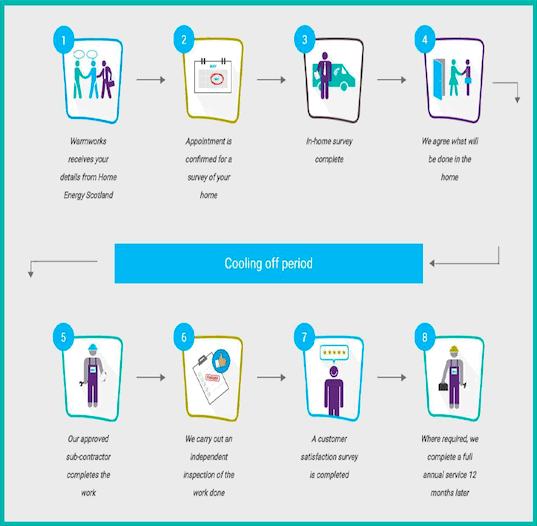
In 2018/19 a total of 1462 customers cancelled their application to Warmer Homes Scotland. This is a decrease of 1.5% on the actual number of cancelled applications in 2017/18, however, proportionately this represents an 8.9% increase from 30% of completed households in 2017/18 to 38.9% of completed households in 2018/19.
| Cancellation reason | 2017/18 | 2018/19 | ||
|---|---|---|---|---|
| Number of Cancellations 17/18 | % of Cancellations 17/18 | Number of Cancellations 18/19 | % of Cancellations 18/19 | |
| Applicant - Due to Contribution | 22 | 1.5 | 8 | 0.1 |
| Applicant Cancelled - Upheaval/Preparation works required | 226 | 15.2 | 251 | 17.2 |
| Applicant Deceased | 12 | 0.8 | 6 | 0.4 |
| Applicant Illness | 100 | 6.7 | 64 | 4.5 |
| Applicant Moving House | 27 | 1.8 | 18 | 1.2 |
| Applicant No Longer Interested (Fuel/Measure Choice) | 447 | 30.1 | 543 | 37 |
| Applicant Not Able To Proceed At This Time | 0 | 0 | 0 | 0 |
| Applicant Not Interested (Other) | 0 | 0 | 0 | 0 |
| Applicant out-with timescales | 379 | 25.5 | 317 | 22 |
| Applicant Private Install | 43 | 2.9 | 24 | 2 |
| Asbestos | 7 | 0.5 | 2 | 0.1 |
| Duplication | 28 | 1.9 | 68 | 4.7 |
| LLP (Landlord refused Works or No Contact) | 17 | 1.1 | 17 | 1.2 |
| No Access (Survey) | 4 | 0.3 | 3 | 0.2 |
| Unable to Contact | 172 | 11.6 | 141 | 9.6 |
| Unknown | 0 | 0 | 0 | 0 |
| Total | 1484 | 1462 | ||
When cancelled applications are compared to the overall number of completed installations in 2018/19 (3818), 38.9% of customers referred to Warmer Homes Scotland cancelled their application in comparison to 30.3% of customers in 2017/18 (4903 completed installations) an overall increase of 8.6%.
The most common reason that customers cancelled their application during 2018/19 was because they were no longer interested in proceeding due to the fuel type or the measures recommended when the initial survey of the property was carried out.
Table 4 indicates that actual number of customers who cancelled their application because they were no longer interested in proceeding increased from 447 in 2017/18 to 543 in 2018/19. When expressed as a percentage of completed applications this has increased 5.1% from 9.1% in 2017/18 to 14.2% in 2018/19.
New renewable measures including ground source heat pumps, micro-wind, micro-hydro and micro-CHP systems will be introduced to the scheme during 2019/20, and these will provide a greater choice of available heating measures, in particular to those households living in off gas areas.
A new form of underfloor insulation will also be added to the scheme in the 2019/20 operating year. Q-Bot installs underfloor insulation to properties using a robot and this system will be of particular benefit to properties where measures available under the scheme previously could not be installed. The innovative system increases the RdSAP rating of the property making it warmer and more affordable to heat.
The introduction of new measures to the scheme may result in a decrease in the future in the numbers of customers cancelling their applications due to unsuitable fuel types or measures.
The second most common reason for cancelled applications is that they were out-with the timescales of the process.
The actual number of applications cancelled for this reason decreased from 379 in 2017/18 to 317 in 2018/19. When expressed as a percentage of completed applications this demonstrates a minimal increase of 0.6% from 7.7% in 2017/18 to 8.3% in 2018/19.
The third most common reason for customers to cancel their application was the perceived upheaval and/or the need for preparation works to the property in advance of an installation. The actual number of customers who cancelled their application for this reason increased from 226 in 2017/18 to 251 in 2018/19. When expressed as a percentage of completed applications this has increased 2% from 4.6% in 2017/18 to 6.6% in 2018/19.
In October 2018, additional enabling measures including asbestos removal and the replacement of old fuel storage tanks plus the addition of energy efficient light bulbs were added to the Warmer Homes Scotland offer with the intention to reduce the number of customers cancelling their application due to the perceived upheaval and/or the need for preparation works and associated costs where financial constraints would previously have prevented them from doing so. This may also have a positive impact on cancellation rates.
Recommendation 1 - Additional enabling measures were introduced to the scheme in October 2018 and further renewable measures will be made available during 2019/20. The 2019/20 Review should analyse the impact on cancellation rates and attrition levels in comparison to previous years, in particular the rates of customer cancellations due to fuel type, no suitable measures or perceived upheaval and/or preparations works to the property.
The Warmworks customer satisfaction scores against the volume of survey returns in 2018/19 are demonstrated at Figure 8. This shows that customer satisfaction levels for those customers who remained in the customer journey process continues to be very high with 99% of customers who completed the survey advising they were satisfied or very satisfied with the overall service received during their Warmer Homes Scotland customer journey during 2018/19. This figure is based on an 86% return rate for completed customer satisfaction surveys. This high level of customer satisfaction indicates that Warmer Homes Scotland customers are happy with the levels of service they receive from Warmworks during their customer journey.
During 2018/19, Warmworks received a total of 182 complaints and this was confirmed by Pennington Choices through the audit process. Warmworks upheld 62 (34%) of the complaints received.
During 2018/19, the overall number of complaints decreased by 8% from 198 received in 2017/18 to 182 in 2018/19. When expressed as a percentage of completed applications, this demonstrates a minimal increase of 0.7% from 4% in 2017/18 to 4.7% in 2018/19.
The number of upheld complaints decreased from 78 in 2017/18 to 62 in 2018/19. When expressed as a percentage of completed applications in 2017/18 and 2018/19 this remains the same at 1.6% for both reporting years.
These figures reinforce the high customer satisfaction rating Warmworks received during 2018/19 and the efforts Warmworks have made to continually improve their standard of service. Although these figures indicate that a very small number of installations, when compared to completed installations, have not been delivered to the standard expected, 99% of Warmer Homes Scotland customers were satisfied or very satisfied with the level of service they received during 2018/19. Going forward Warmworks will continue to monitor their customer satisfaction scores to maintain the high standard of service they provide.
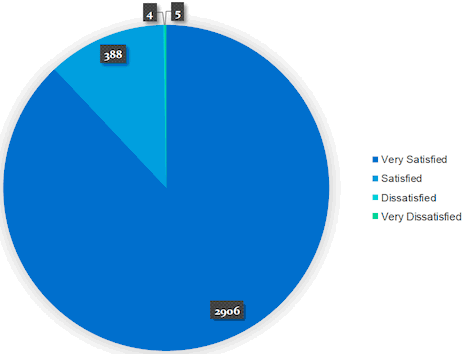
The evidence presented indicates that Warmer Homes Scotland is an attractive option for customers. However, consideration should be given to ensuring those eligible customers referred to the scheme take up the offer of support available and complete their customer journey. The high customer satisfaction score of 99% achieved by Warmworks during 2018/19 has the potential to generate additional referrals to the scheme as a result of satisfied customers using word of mouth to promote a positive experience and reputation for the scheme.
Contact
Email: CEU@gov.scot
There is a problem
Thanks for your feedback